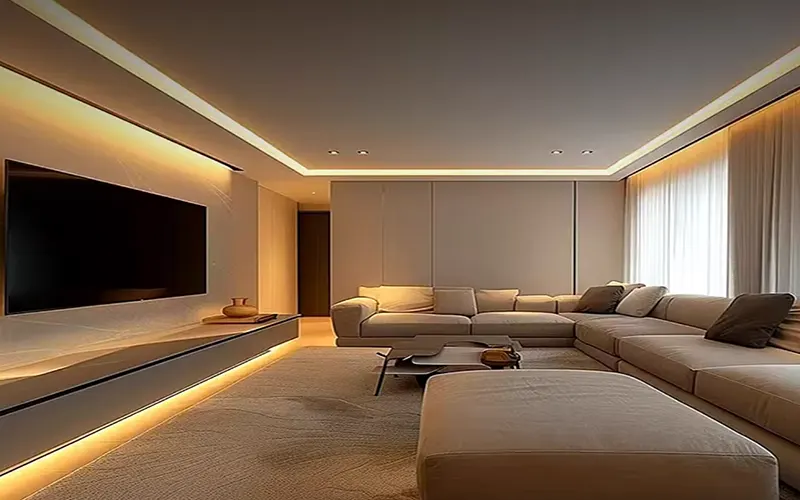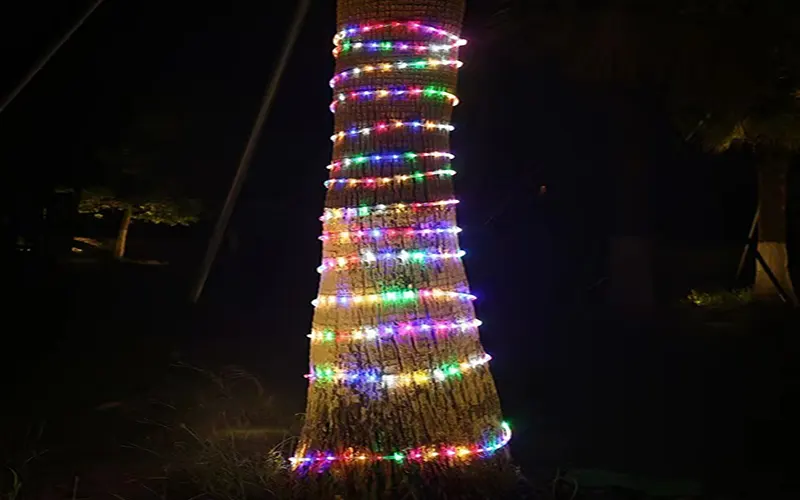In the field of modern decorative lighting, LED light strips and LED light cords are ubiquitous outdoors. These two types of lighting products are among the most popular and also the most often confused. Most of the time, we mistake one for the other. They look similar, yet they differ significantly in structure, purpose, and performance. This article provides a detailed analysis of the differences between LED strip light vs LED rope light, helping you understand their respective characteristics and application scenarios, and enabling you to choose the most suitable lighting solution.
Main Difference: LED Strip Light vs LED Rope Light
In fact, both LED strip lights and LED rope lights belong to the category of flexible linear lighting products. However, they differ significantly in product structure design, application scenarios, flexibility, weather resistance, installation methods, and maintenance costs. Understanding these differences helps in selecting the most suitable product for different projects.

1. Product Structure Differences: PCB Board vs. Round Encapsulated Flexible Tube
- LED strip lights use flexible printed circuit boards (FPCs) as a carrier, on which SMD LEDs, such as 2835, 5050, 2216, and COB, are mounted. Therefore, LED strip lights are typically flat, only 1–3 mm thick, and generally 5–12 mm wide. They are also cut to size, making installation very convenient.
- LED rope lights, also known as LED flexible tube lights or round rope lights, have LED chips encased in thick PVC or silicone round tubes, approximately 10–16 mm in diameter. They are fully sealed, with internal wiring not visible. Therefore, they have a thicker structure, stronger current carrying capacity, and can support power supply over longer distances.
2. Comparison of Appearance and Flexibility
- LED light strips are extremely thin and light, easily fitting into furniture, walls, ceilings, etc. They are suitable for wiring in confined spaces, and for recessed or concealed lighting, such as under-cabinet lights and ceiling recessed lights.
- LED light cords, on the other hand, have a round appearance and a large diameter, visually resembling “bright lines.” They are not suitable for small, flexible spaces. However, they are highly pressure-resistant, able to withstand being stepped on or driven over, and are not easily damaged.
3. Differences in Waterproof Ratings
- LED light strips offer various waterproof rating options. For indoor, dry locations, IP20 bare boards are sufficient. For indoor and outdoor locations with water, we recommend IP67 or higher. For outdoor locations exposed to water or underwater, we suggest using IP68 neon tubes, which achieve an IP68 waterproof rating and are suitable for underwater and swimming pool lighting.
- Most LED rope lights offer IP67 or IP68 deep waterproof ratings. They can withstand short-term immersion, prolonged rain, or harsh outdoor weather.
4. Installation Method Differences:
- LED light strips are very easy to install, mainly because they come with 3M adhesive on the back for quick and easy attachment to flat surfaces. However, for waterproof LED strips, we recommend using LED profiles and clips for installation, as this will provide greater stability and reliability.
- LED light cords, on the other hand, absolutely require the use of dedicated clips, brackets, or fixing clamps. Currently, this is the only installation method available, but it results in a more secure installation and prevents the light from falling off.
5. Interior Decoration vs. Outdoor Projects & Outline Lighting
- LED light strips can be used both indoors and outdoors, and their applications are very wide-ranging. They are primarily used for ambient lighting, such as under-cabinet lights, ceiling reflectors, and interior architectural linear lights.
- LED light ropes are mainly used for building exterior lighting, and are commonly used for tree and bridge decorative lighting. They are also used in seasonal theme parks and holiday lighting projects.
6. Maintenance and Lifespan
- LED light strips can be cut and soldered for repair. They also have a longer lifespan and are more energy-efficient.
- LED light ropes have a tightly sealed internal structure, making localized repair difficult once damaged. However, they also have a longer lifespan, especially outdoors.
7. Cost and Price
- LED strip lights are more affordable due to their lower cost. They also have lower maintenance costs.
- LED light ropes are more expensive, primarily due to higher raw material costs, but they offer more reliable performance for outdoor applications.
Which Lighting Applications Choose LED Tape?
LED light strips, also known as flexible light strips, are widely loved by designers and DIY enthusiasts for their unique “plasticity.” They are now widely used in architectural and engineering lighting.

Ceiling Recess Lighting
Light LED strips are ultra-thin, continuous, and highly flexible, making them suitable for concealing within ceiling reflective grooves to produce soft, even, indirect lighting without the light source being visible. They can create a sophisticated, clean, and uniform ambient light on the ceiling.
Under Cabinet / Cabinet Lighting
Thin, with good heat dissipation and cuttable, LED strips are ideal for narrow furniture structures, allowing for concealed installation and providing practical lighting. They are primarily used at the bottom of kitchen wall cabinets and inside wardrobe shelves, which is highly practical as it improves visibility. Furthermore, illuminating the contents of the cabinets makes the displays more visually appealing.
Stair & Corridor Lighting
LED ribbon offer uniform linearity and can be installed along the sides of stairs or under the treads to provide safe lighting while also offering a modern visual effect. They are most commonly installed below the leading edge of stair treads and at the bottom of the handrail. They provide basic safe light that is not glaring at night, and also make the stairs more clearly visible.
TV Backlight
We can install LED light strips along the back of the TV or the background wall to create soft backlighting, reduce contrast, and protect the eyes. At the same time, it can alleviate eye fatigue caused by strong contrast light.
Commercial Space Display and Shelf Lighting
Light strips provide continuous, seamless light, highlighting product outlines and can be concealed within display cases. They enhance product brightness, making displays more eye-catching.
Bedroom Ambient Lighting
The LED strips are concealed behind the bedside, creating a more comfortable and softer light in the bedroom, while also providing gentle illumination for nighttime use. This adds depth and design flair to the bedroom.
Which Lighting Applications Choose LED Rope Light?
LED rope light are products that encapsulate LED chips within a sturdy, flexible PVC or silicone tube, emphasizing protection and durability. Primarily designed for outdoor use, they withstand rain and dust.

Building Facade Outline Lighting
Circular light strips offer strong continuity, making them ideal for outlining the edges of buildings. Furthermore, their PVC/silicone material is highly weather-resistant, allowing for long-term exposure to sun and rain. We can see them used for outline lighting on the exterior walls of shopping malls and the facades of office buildings.
Outdoor Landscape Decoration
LED rope lights are highly waterproof and can withstand rain, mud, and damp plant environments. They can be used for decoration along garden paths, especially for wrapping trees. They improve visibility and safety at night while also creating a romantic and festive atmosphere.
Water Feature Decoration
They can withstand prolonged exposure to moisture, but are not recommended for submersion. We can install LED rope lights around the pool, along with waterproof line lights and the edges of hotel water features and fountains. This enhances the nighttime ambiance of the pool and water features.
Festival and Event Decorative Lighting
Its moderate flexibility makes it ideal for wrapping, hanging, and creating decorative arrangements. Waterproof and cold-resistant, it can be used for winter activities. Primarily designed for decorating various important holidays, it provides soft, continuous light with strong visual appeal.
Linear Decoration for Bridges and Public Spaces
LED light ropes are suitable for large-scale, long-term, and stable lighting projects. They can be bent, wrapped, and installed along edges. They outline the light patterns of public spaces and are commonly used in theme park road structures and park walkway edges.
LED Strip Light vs LED Rope Light: How to Choose Them?
Both LED strip lights and LED rope light are excellent lighting products. Ultimately, the decision on which to choose rests with your specific lighting needs.
Choosing LED Strip Lights
- The purpose is functional lighting or concealed ambient lighting (such as illuminating kitchen countertops or outlining ceilings).
- High brightness is required to achieve the desired supplemental lighting.
- You plan to embed or attach the light source within cabinets or recesses, aiming for a “light without seeing the lamp” effect.
Choosing LED Light Ropes
- This device needs to be used outdoors (courtyard, balcony) or in damp environments.
- You want a three-dimensional installation method, such as hanging or wrapping, like an outdoor tree, rather than attaching it to a flat surface.
- You prefer a crystal-clear, dotted lighting effect and a retro industrial style.
Conclusion
While both LED Strip Light vs LED Rope Light are flexible lighting products, they each have their own advantages and disadvantages. You need to consider your usage environment, brightness requirements, and budget. For more high-quality CRI90 LED strip lights and outdoor LED neon tubes, please contact us.
FAQs
Yes, but we do not recommend mixing them directly. Because they are different, you need to ensure both use the same voltage (usually 12V or 24V), and the total power (wattage) of your power supply must be greater than the total power consumption of all the lights you connect.
Some low-voltage LED light cords can be cut at the marked point, but must be resealed with waterproof end caps. We do not recommend cutting LED light cords.
LED light strips offer a more delicate and softer light effect, with a variety of color temperatures to choose from. COB light strips, in particular, provide continuous, non-point-like light, making them ideal for home and decorative lighting.
We recommend LED light strips, which can meet the needs of high-brightness countertop lighting. They can be perfectly concealed under wall cabinets, and models with a high color rendering index (CRI) of RA>90 can be selected to more realistically display the colors of food.
